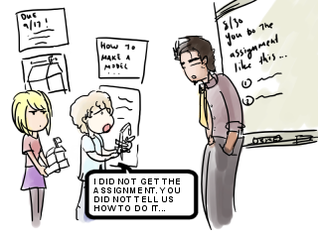TPE 2: Monitoring Student Learning During Instruction
|
Students are learning every moment they are in the classroom. It is therefore important that a teacher knows approximately where the students are before a lesson, during a lesson, and after a lesson. This is to ensure that students meet the objectives and goal set by the teacher for the lesson. If the teacher finds that the students are failing to meet those understanding, an adjustment is needed immediately to compensate for the assimilation of knowledge.
There are many methods for checking student's progress and the traditional method has always been a formal written assessment. This type of assessment is fine as a summative or final assessment, but should not be the only way for teachers to check if a student had learn anything. The main reason for not always using this form of knowledge judgement is that it does not give the teacher a complete developmental and progress report of where the students are at. Breakfast Like the first meal before the start of the day, assessing students before a lesson can give teachers and student a general idea of what is going to happen. For the instructor, they are given a glimpse of the knowledge that the students already possess on the subject matter, and how much they know may effect how much and what you teach. It may also reveal experts of that subject in your class. For the effective teacher, this would mean that the student that knows a lot on the matter can become the expert that other students may go to for help or information. Lunch time! The day is long and lunch is the mid-day refueling time. Throughout a lesson a teacher will commonly have to figure out what a student is doing or if they truly understand the material. The easiest and most common method for monitoring their learning is by doing an informal check for understanding. This may be as simple as asking the student to explain to you what they are doing, or they may recite to you what the main purpose of the lesson is and if they think they are on track. Dinner At the end of the lesson it is best to find out if the students were able to reach the lesson's objective. By doing this you can determine if there your final overall objective were met. Normally, these assessments are done as a project or formal written assessment. Water Cycle When I performed my lesson on the water cycle I immediately jumped into teaching, moved into a quick guided practice, and left the students to do their independent practice. Before moving from one step to another though, I would do a simple check such as a impromptu quiz. For my first transition from direct instruction into guided practice I had asked the student to do a think-pair-share. I would listen in when the students discussed what they had observed and compared it to their hypothesis; if the students were slightly off I would guide them towards the correct answer until they make the connection themselves. All of the students understood the concepts well and had most of the class misunderstoof the concept I would have approached the teaching in a different manner. |
| CA- CCTC: TPE's (Teaching Performance Expectations) |
| Standard : A. Making Subject Matter Comprehensible to Students |
| TPE : TPE
1: Specific Pedagogical Skills for Subject Matter Instruction TPE 1 is divided into two categories intended to take into account the differentiated teaching assignments of multiple subject and single subject teachers. Multiple subject credential holders work in self-contained classrooms and are responsible for instruction in several subject areas; single subject teachers work in departmentalized settings and have more specialized assignments. These categories are Subject-Specific Pedagogical Skills for Multiple Subject Teaching Assignments (1-A), and Subject-Specific Pedagogical Skills for Single Subject Teaching Assignments (1-B). |
| Component : TPE 1A: Subject-Specific Pedagogical Skills for Multiple Subject Teaching Assignments |
|
Standard Area : Teaching
Reading-Language Arts in a Multiple Subject Assignment Candidates for a Multiple Subject Teaching Credential demonstrate the ability to teach the state-adopted academic content standards for students in English-Language Arts (K-8). They understand how to deliver a comprehensive program of systematic instruction in word analysis, fluency, and systematic vocabulary development; reading comprehension; literary response and analysis; writing strategies and applications; written and oral English Language conventions; and listening and speaking strategies and applications. They know how to strategically plan and schedule instruction to ensure that students meet or exceed the standards. Candidates create a classroom environment where students learn to read and write, comprehend and compose, appreciate and analyze, and perform and enjoy the language arts. They understand how to make language (e.g., vocabulary, forms, uses) comprehensible to students and the need for students to master foundational skills as a gateway to using all forms of language as tools for thinking, learning, and communicating. They understand how to use instructional materials that include a range of textual, functional and recreational texts and how to teach high quality literature and expository text. They understand that the advanced skills of comprehending narrative and informational texts and literary response and analysis, and the creation of eloquent prose, all depend on a foundation of solid vocabulary, decoding, and word-recognition skills. Candidates teach students how to use visual structures such as graphic organizers or outlines to comprehend or produce text, how to comprehend or produce narrative, expository, persuasive and descriptive texts, how to comprehend or produce the complexity of writing forms, purposes, and organizational patterns, and how to have a command of written and oral English-language conventions. They know how to determine the skill level of students through the use of meaningful indicators of reading and language arts proficiency prior to instruction, how to determine whether students are making adequate progress on skills and concepts taught directly, and how to determine the effectiveness of instruction and students’ proficiency after instruction. |

